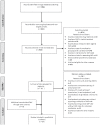Inappropriateness of medication prescriptions to elderly patients in the primary care setting: a systematic review
- PMID: 22928004
- PMCID: PMC3425478
- DOI: 10.1371/journal.pone.0043617
Inappropriateness of medication prescriptions to elderly patients in the primary care setting: a systematic review
Abstract
Background: Inappropriate medication prescription is a common cause of preventable adverse drug events among elderly persons in the primary care setting.
Objective: The aim of this systematic review is to quantify the extent of inappropriate prescription to elderly persons in the primary care setting.
Methods: We systematically searched Ovid-Medline and Ovid-EMBASE from 1950 and 1980 respectively to March 2012. Two independent reviewers screened and selected primary studies published in English that measured (in)appropriate medication prescription among elderly persons (>65 years) in the primary care setting. We extracted data sources, instruments for assessing medication prescription appropriateness, and the rate of inappropriate medication prescriptions. We grouped the reported individual medications according to the Anatomical Therapeutic and Chemical (ATC) classification and compared the median rate of inappropriate medication prescription and its range within each therapeutic class.
Results: We included 19 studies, 14 of which used the Beers criteria as the instrument for assessing appropriateness of prescriptions. The median rate of inappropriate medication prescriptions (IMP) was 20.5% [IQR 18.1 to 25.6%.]. Medications with largest median rate of inappropriate medication prescriptions were propoxyphene 4.52 (0.10-23.30)%, doxazosin 3.96 (0.32 15.70)%, diphenhydramine 3.30 (0.02-4.40)% and amitriptiline 3.20 (0.05-20.5)% in a decreasing order of IMP rate. Available studies described unequal sets of medications and different measurement tools to estimate the overall prevalence of inappropriate prescription.
Conclusions: Approximately one in five prescriptions to elderly persons in primary care is inappropropriate despite the attention that has been directed to quality of prescription. Diphenhydramine and amitriptiline are the most common inappropriately prescribed medications with high risk adverse events while propoxyphene and doxazoxin are the most commonly prescribed medications with low risk adverse events. These medications are good candidates for being targeted for improvement e.g. by computerized clinical decision support.
Conflict of interest statement
References
-
- Parker MG, Thorslund M (2007) Health trends in the elderly population: getting better and getting worse. Gerontologist 47: 150–158. 47/2/150 [pii]. - PubMed
-
- Boyd CM, Darer J, Boult C, Fried LP, Boult L, et al.. (2005) Clinical practice guidelines and quality of care for older patients with multiple comorbid diseases: implications for pay for performance. JAMA 294: 716–724. 294/6/716 [pii];10.1001/jama.294.6.716 [doi]. - PubMed
-
- Thomsen LA, Winterstein AG, Sondergaard B, Haugbolle LS, Melander A (2007) Systematic review of the incidence and characteristics of preventable adverse drug events in ambulatory care. Ann Pharmacother 41: 1411–1426. aph.1H658 [pii];10.1345/aph.1H658 [doi]. - PubMed
-
- Hanlon JT, Schmader KE, Koronkowski MJ, Weinberger M, Landsman PB, et al. (1997) Adverse drug events in high risk older outpatients. J Am Geriatr Soc 45: 945–948. - PubMed
Publication types
MeSH terms
LinkOut - more resources
Full Text Sources
Research Materials


